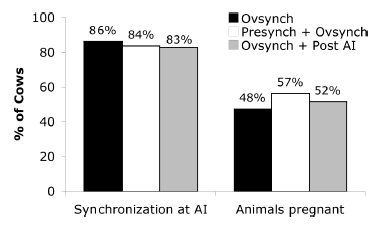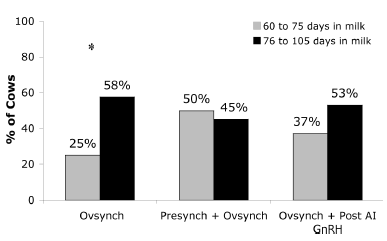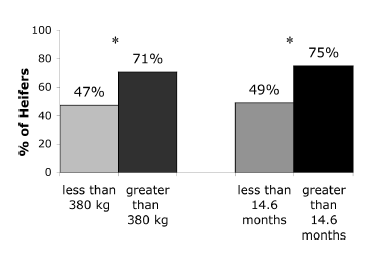



Improving Ovulation And Pregnancy In Ovsynch Treated Animals
The Ovsynch timed artificial insemination (AI) protocol offers producers potential freedom from estrus detection difficulties. This report from the University of British Columbia looks at strategies to improve ovulation and pregnancy in these treated cows and heifers.In response to poor estrus detection and low fertility in lactating dairy cows, reproductive management tools such as estrus synchronization programs are increasingly used on dairy farms. One tool, the Ovsynch timed artificial insemination (AI) protocol offers producers potential freedom from estrus detection difficulties. The Ovsynch protocol involves injecting gonadotropin-releasing hormone (GnRH), followed 7 days later by injecting prostaglandin F2a (PGF2a), and then 48 hours later by a second injection of GnRH. Animals are then inseminated 14 to 16 hours later. The economical benefits of Ovsynch are based on reducing the interval from calving to first AI, reducing the number of days animals are open, and reducing culling of cows because of reproductive problems. While cows treated with Ovsynch have similar pregnancy results to cows bred at natural estrus (~30 per cent), this is still far from satisfactory.
Initiating Ovsynch protocol at specific stages of the estrous cycle has been associated with reduced pregnancy success. Initiating Ovsynch during the late luteal phase (days 15 to 17 of the estrous cycle) may not result in ovulation and formation of a corpus luteum while initiating treatment during the first 2 to 3 days of the cycle results in less fertile oocytes being ovulated. These difficulties have resulted in research focusing on presynchronization before Ovsynch protocol in order to initiate it at the optimum time, which is between days 7 to 10 of the cycle.
Although ovulation and fertilization are high (80 to 90 per cent) following estrus and insemination, early embryonic loss significantly contributes to the low pregnancy success observed in lactating cows. Inadequate corpus luteum function resulting in decreased progesterone production is a major factor that contributes to early embryonic loss. Progesterone is an important hormone in the maintenance of pregnancy. The administration of GnRH post insemination has been shown to induce the formation of an additional corpus luteum, arising from the ovulation of follicles present at the time of Ovsynch treatment.
Reproductive performance in heifers has remained high over the years (65 to 75 per cent), and time spent on estrus detection is much less when compared to lactating cows. Any delay to first service insemination will increase age at first calving as well as increase associated costs. The use of Ovsynch may help to overcome these issues.
This study examined two strategies to improve ovulation and pregnancy following Ovsynch protocol of 225 Holstein lactating cows and 87 Holstein heifers. Animals were randomly assigned to one of three treatments for first service breeding: 1) Ovsynch treatment only 2) Ovsynch treatment preceded by Presynch (PGF2_ 14 and 28 days earlier); 3) Ovsynch treatment followed 6 days later by GnRH.
Milk (from cows) and blood (from heifers) samples were taken from each animal to determine progesterone concentrations on days 0 (AI), 7, 14, 21, and 28, which were used to assess ovulation and corpus luteum function. The percent of animals synchronized at AI was obtained from the number of animals with milk or blood progesterone levels less than 1 ng/mL on the day of breeding (signifying that the animal was in estrus). Pregnancy was determined by ultrasound 40 days after breeding.
No differences in the percent of either cows or heifers pregnant between treatments were observed (Figure 1 and 2). A significant difference in pregnancy was observed between heifers (67 per cent) and lactating cows (52 per cent). Cows treated with Ovsynch alone had lower pregnancy when bred less than 76 days in milk compared to cows on the Presynch or Post-AI GnRH treatments at AI (Figure 3). Also a smaller proportion of heifers were pregnant when bred before 14.6 months of age than after 14.6 months of age (Figure 4). Many heifers are usually first bred when they reach about 13 to 15 months of age.
This study did not reveal any differences in the percent of animals synchronized between the three treatments at timed artificial insemination or pregnant 40 days later. However, it was observed that days in milk for lactating cows in the Ovsynch only treatment affected the percentage of animals pregnant. Similarly, the age and weight of heifers affected the per cent animals pregnant.




July 2010


